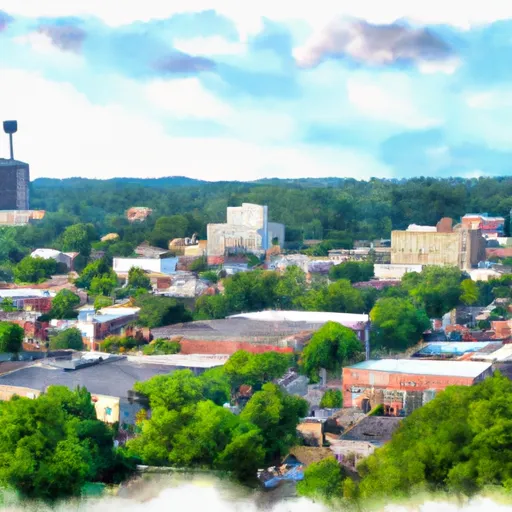-
 Snoflo Premium
Snoflo Premium
Get unlimited access to all our content
With no Ad interruptions! - Start Your Free Trial Login with existing account
West-Point
Eden Index
Climate
7.9
•
Recreation
5.2
•
Community
1.8
•
Safeguard
5.4/10

West Point, Georgia is a charming city located in Troup County, nestled on the banks of the Chattahoochee River. The area experiences a humid subtropical climate, characterized by hot and humid summers, while winters are mild with occasional cold snaps. The average annual temperature is around 68°F (20°C), making it an ideal destination for outdoor enthusiasts throughout the year.
The hydrology constituents of West Point are primarily shaped by the Chattahoochee River. The river provides a picturesque backdrop, offering opportunities for fishing, boating, and various water sports. West Point Lake, a reservoir formed by the damming of the Chattahoochee River, is a popular spot for swimming, kayaking, and camping.
Outdoor recreation opportunities in West Point are abundant. The city is home to several parks, including the West Point River Park, where visitors can enjoy picnicking, hiking, and birdwatching. The Chattahoochee Valley Railroad Trail offers scenic biking and walking paths along the riverfront. Additionally, visitors can explore the nearby West Point Wildlife Management Area, which offers activities such as hunting, fishing, and wildlife observation.
With its pleasant climate, beautiful hydrology constituents, and diverse outdoor recreation opportunities, West Point, Georgia is a haven for nature lovers and adventure seekers alike.
What is the Eden Index?
The Snoflo Eden Index serves as a comprehensive rating system for regions, evaluating their desirability through a holistic assessment of climate health, outdoor recreation opportunities, and natural disaster risk, acknowledging the profound impact of these factors on livability and well-being.
Climate Health Indicator (CHI): 7.9
West-Point receives approximately
1299mm of rain per year,
with humidity levels near 86%
and air temperatures averaging around
17°C.
West-Point has a plant hardyness factor of
8, meaning
plants and agriculture in this region tend to thrive here all year round.
By considering the ideal temperature range, reliable water supplies, clean air, and stable seasonal rain or snowpacks, the Climate Health Indicator (CHI) underscores the significance of a healthy climate as the foundation for quality living.
A healthy climate is paramount for ensuring a high quality of life and livability in a region, fostering both physical well-being and environmental harmony. This can be characterized by ideal temperatures, reliable access to water supplies, clean air, and consistent seasonal rain or snowpacks.
Weather Forecast
Streamflow Conditions
Apalachicola
Area Rivers
Apalachicola
Snowpack Depths
Apalachicola
Reservoir Storage Capacity
Apalachicola
Groundwater Levels
Recreational Opportunity Index (ROI): 5.2
The Recreational Opportunity Index (ROI) recognizes the value of outdoor recreational options, such as parks, hiking trails, camping sites, and fishing spots, while acknowledging that climate plays a pivotal role in ensuring the comfort and consistency of these experiences.
Access to outdoor recreational opportunities, encompassing activities such as parks, hiking, camping, and fishing, is crucial for overall well-being, and the climate plays a pivotal role in enabling and enhancing these experiences, ensuring that individuals can engage in nature-based activities comfortably and consistently.
Camping Areas
| Campground | Campsites | Reservations | Toilets | Showers | Elevation |
|---|---|---|---|---|---|
| White Oak Creek | None | 237 ft | |||
| Hardridge Creek | None | 215 ft | |||
| Florida Caverns State Park | None | 144 ft | |||
| Bluff Creek | 88 | 217 ft | |||
| Cotton Hill | None | 214 ft | |||
| Uchee Creek Military | None | 222 ft | |||
| Three Rivers State Park | None | 180 ft | |||
| LakePoint State Park | 192 | 208 ft | |||
| Florence Marina State Park | None | 192 ft | |||
| Torreya State Park | None | 263 ft |
Nearby Ski Areas
Catastrophe Safeguard Index (CSI):
The Catastrophe Safeguard Index (CSI) recognizes that natural disaster risk, encompassing floods, fires, hurricanes, and tornadoes, can drastically affect safety and the overall appeal of an area.
The level of natural disaster risk in a region significantly affects safety and the overall livability, with climate change amplifying these risks by potentially increasing the frequency and intensity of events like floods, fires, hurricanes, and tornadoes, thereby posing substantial challenges to community resilience and well-being.
Community Resilience Indicator (CRI): 1.8
The Community Resilience Indicator (CRI) recognizes that education, healthcare, and socioeconomics are crucial to the well-being of a region. The CRI acknowledges the profound impact of these elements on residents' overall quality of life. By evaluating educational resources, healthcare accessibility, and economic inclusivity, the index captures the essential aspects that contribute to a thriving community, fostering resident satisfaction, equity, and social cohesion.

